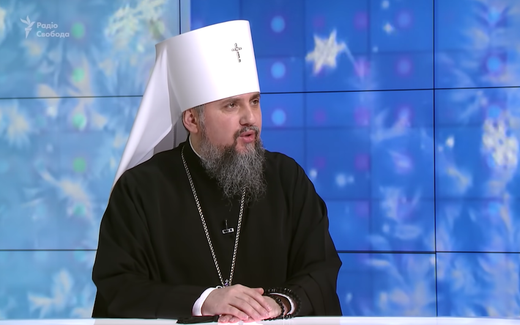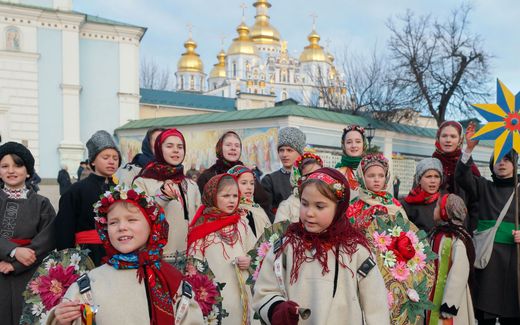Five questions about Easter in the Eastern Orthodox Church

Russian Orthodox believer during Easter celebration. Photo EPA, Igor Kovalenko
Eastern Europe
Worldwide, Christians will celebrate and commemorate the resurrection of Christ in the coming weeks. Especially in the Eastern Orthodox Church, this is a big happening. Five questions and answers.
What does an Easter Celebration look like in the Eastern Orthodox Church?
This feast is celebrated massively. All believers come together in a massive church service, which starts at midnight on Easter Sunday when the church bells ring in every Orthodox church building. Often the service begins with the church building being entirely darkened. The highest clergyman then lights a candle to illustrate Christ's victory over the dark grave. The religious celebration lasts for hours and is usually not finished until 3.00 a.m. or 4.00 a.m.
Part of the liturgy is the proclamation of the Easter story by priests and choir who sing hymns in antiphony. That means that, for example, the priests sing a question and the choir replies. The setting in the Church is furthermore characterised by candlelight, the smell of incense and processional rituals. One recurring occurrence is the declamation of the highest clergyman present: "Christ has risen." To which all attendants respond: "The Lord has risen indeed."
During the whole service, believers are expected to stand. In many Orthodox churches, there are no pews or chairs. However, many of them do not attend the entire celebration. It is easy to walk in and out.
The Easter services are more or less the same for all Eastern Orthodox Churches.
Easter celebrations are preceded by the Great Lent, which marks the beginning of the Orthodox Passion Time. Great Lent starts about seven weeks before Pascha takes place. It is the most important fasting season of the Eastern Orthodox tradition. The purpose of this prelude to Pascha is to repent from sins and dedicate life to God.
The Great Lent ends with Holy Week. Jesus' entrance into Jerusalem is then commemorated, but also His death on the cross and His burial. During this week, special church services are held.
The culminating point, however, is Easter itself.
What is the importance of Easter for the Eastern Orthodox Church?
Easter, also called Pascha, is the most important Christian feast in the Eastern Orthodox Church. Eastern Orthodox Christians see this holiday as symbolising the victory of light over darkness and the triumph of life over death. They believe that the event of the Resurrection of Christ has great importance, not only for believers but for the whole cosmology that had been miserable since creation.
This understanding of the world's redemption is likely connected to the fact that the Eastern European cultures have a more communal identity than the Church of Western Europe. The latter is more focused on individual salvation and personal faith. For that reason, Christmas is more central in the Western Church.
In addition, Easter is essential for the Eastern Orthodox Church because it is the feast of praise par excellence. For Eastern Orthodox believers, Easter symbolises the glorification of Christ, in general, more than Christmas, Ascension Day or Pentecost. Traditionally, praise and worship have been foundational to Orthodox theology, which focuses much on experiential faith. Celebrating Easter in congregational worship connects to this sentiment.
What are important symbols connected to Easter?
One of the notable Easter traditions among Eastern Orthodox Christians is the Paschal greeting, which begins with the sentence: "Christ has risen." To which is responded: "Truly, He has risen."
Furthermore, Easter eggs are present to symbolise new life. Orthodox Christians paint them red to illustrate the shedding of the blood of Christ. Other meanings are attributed to the hard shell of the egg, which symbolises the grave. The cracking of the shell then represents the opening of the tomb and Christ's resurrection.
In addition, special Easter meals are served. In some traditions, bread is a substantial dish. The Greek Orthodox Christians eat a sweet Easter dessert bread, for example. In other cultures, the meat of a lamb is eaten as well, for instance, in Serbia.
Moreover, icons play an essential role in general in the Eastern Orthodox Church, and thus also during Easter celebrations. Clergymen carry the two-dimensional icons around in processions, for example. Often, these icons show Jesus in a conquering position. On some icons, He is portrayed as rescuing the human beings from hell. It is important to note that these icons are not worshipped but help laypeople understand Easter's story.
Candles are also used to symbolise the victory of light over darkness. In some traditions, the Priest uses a candle to light the candle of other believers and spread the light throughout the Church. The candlelight is sometimes also seen as representing Christ Himself as the Light of the world.
To what extent does the Eastern Orthodox Church differ from the Western Church with its emphasis on Easter?
Whereas the Eastern Orthodox Church sees Easter as the most important Christian holiday, its Western counterpart seems to put more emphasis both on Christmas and Good Friday.
A possible explanation for this difference is linked to the fact that the Western Church is established in societies that underwent both the period of Reformation and the era of Humanism. These movements have led to more individualisation than is seen in Eastern cultures. As a result, Western theology puts more emphasis on personal salvation and faith than the Eastern Church does. That would explain why the Western Church focuses more on Good Friday, also seen as the "payday of the Church" on which Christ paid with His blood for the sins of true believers.
Why do some Eastern Orthodox congregations celebrate Easter on a different day than their Western counterparts?
The Eastern Orthodox Church bases its church year on a different calendar than the Western Church. The first uses the Julian calendar, which Julius Caesar made in 45 B.C. The Western Church bases its church year on the Gregorian calendar, which Pope Gregory XIII produced in 1585. The Gregorian calendar corresponded more accurately to the astronomical year. Western countries adopted it, but the Eastern Orthodox Church rejected it because it did not see Pope Gregory XIII as its legitimate head.
The result of the use of different calendars is that the Eastern Orthodox Church and its Western counterpart do not celebrate Christian holidays on the same day anymore. Orthodox Christians in Russia, Romania and Greece will celebrate Easter on April 24 this year, while the Western tradition commemorates Christ's resurrection coming Sunday. However, some Eastern Orthodox Churches follow the Gregorian calendar nowadays. For example, Polish Orthodox Christians will celebrate Easter on April 17 as well.
Related Articles






